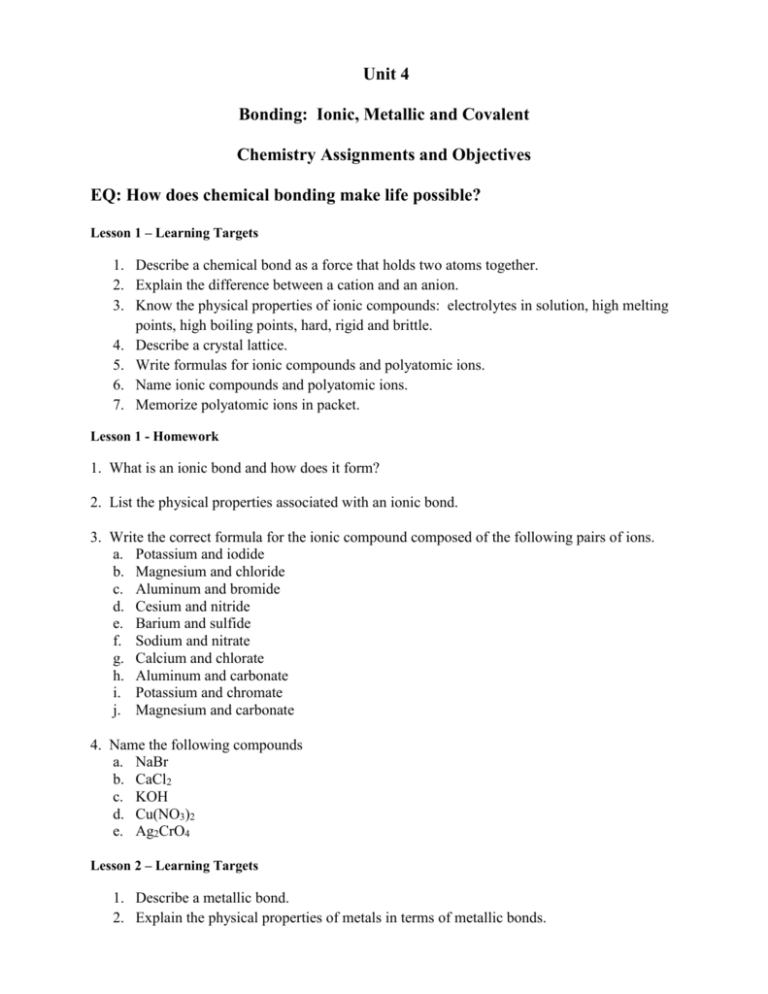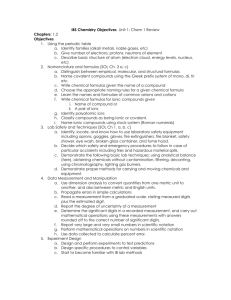Homework packet - Science with Horne
advertisement

Unit 4 Bonding: Ionic, Metallic and Covalent Chemistry Assignments and Objectives EQ: How does chemical bonding make life possible? Lesson 1 – Learning Targets 1. Describe a chemical bond as a force that holds two atoms together. 2. Explain the difference between a cation and an anion. 3. Know the physical properties of ionic compounds: electrolytes in solution, high melting points, high boiling points, hard, rigid and brittle. 4. Describe a crystal lattice. 5. Write formulas for ionic compounds and polyatomic ions. 6. Name ionic compounds and polyatomic ions. 7. Memorize polyatomic ions in packet. Lesson 1 - Homework 1. What is an ionic bond and how does it form? 2. List the physical properties associated with an ionic bond. 3. Write the correct formula for the ionic compound composed of the following pairs of ions. a. Potassium and iodide b. Magnesium and chloride c. Aluminum and bromide d. Cesium and nitride e. Barium and sulfide f. Sodium and nitrate g. Calcium and chlorate h. Aluminum and carbonate i. Potassium and chromate j. Magnesium and carbonate 4. Name the following compounds a. NaBr b. CaCl2 c. KOH d. Cu(NO3)2 e. Ag2CrO4 Lesson 2 – Learning Targets 1. Describe a metallic bond. 2. Explain the physical properties of metals in terms of metallic bonds. 3. Define an alloy as a mixture of metals. Lesson 2 - Homework 1. What is a metallic bond? 2. What is an alloy? 3. Describe the properties of metals. Lesson 3 – Learning Targets 1. 2. 3. 4. Apply the octet rule to atoms that bond covalently. Explain the formation of single, double and triple bonds. Name molecular formulas. List the steps used in drawing Lewis structures and be able to draw structures from formulas 5. Write molecular formulas from their names. 6. Name binary acids and oxyacids. Lesson 3 Homework 1. Name the following binary covalent compounds a. CCl4 b. As2O3 c. CO d. SO2 e. NF3 f. NH3 g. CH4 2. Write the molecular formula for each of the following compounds. a. Disulfur trioxide b. Iodic acid c. Dinitrogen monoxide d. Hydrofluoric acid e. Phosphorus pentachloride f. Dinitrogen trioxide g. Hydrochloric acid h. Chloric acid i. Sulfuric acid j. Sulfurous acid 3.What is the difference between a binary acid and an oxyacid? 4. Name the following acids, assuming that each compound is dissolved in water. a. HI b. c. d. e. HClO3 HClO2 H2SO4 H2S Lesson 4 – Learning Targets 1. 2. 3. 4. 5. Explain why boron only forms three covalent bonds. Discuss the VSEPR bonding theory (Valence Shell Electron Pair Repulsion.) Know the five basic shapes of molecules. (Bent and pyramidal are caused by lone pairs.) Describe how electronegativity is used to determine bond type. Compare and contrast polar and nonpolar covalent bonds AND polar and nonpolar molecules. 6. Know the properties of covalent molecules. (Opposite of ionic compounds.) Lesson 4 - Homework 1. Draw a Lewis Structure for each of the following. a. NF3 b. CS2 c. BH3 2. Determine/draw the molecular geometry for the following. Determine if the compound is polar or non-polar. a. BF3 b. OCl2 c. CF4 d. SCl2 e. NH2Cl f. CO2 g. CF2Cl2 h. H2O 3. Why is the CF4 molecule non polar even though it contains polar bonds? 4. Rank the following bonds according to increasing polarity. C—H N—H Si—H O—H Cl—H Unit 4 Review Lewis Dot Structure Drawing Practice For each molecule, draw the Lewis dot diagram: 1. 2. 3. 4. CO2 O2 CH4 H2O 7. BF3 8. H2 9. NH3 10. HCl 5. SF4 6. N2 11. BeCl2 12. CF4 Ionic Compounds Practice 1. Give the electron dot diagram for the following elements. a. Carbon b. fluorine c. hydrogen d. sodium 2. Give names for the following formula units. a. BaCl2 e. NaF b. FeI3 f. Zn(OH)2 c. CaCO3 g. Li3PO4 d. Cu(ClO2)2 h. NiCl2 3. Give the formula units for the following names. a. Iron(II) Sulfate e. Aluminum Nitrate b. Lead(III) Oxide f. Magnesium Phosphide c. Potassium Bicarbonate g. Calcium Fluoride d. Beryllium Nitrite h. Manganese (IV) Bromide Compound Names and Formulas For the list on the left, name the compound. For the list on the right, give the chemical formula that corresponds to the name. Give Name Write Formula 1) NaF 13) potassium fluoride 2) K2CO3 14) ammonium sulfate 3) MgCl2 15) magnesium iodide 4) Be(OH)2 16) copper (II) sulfite 5) SrS 17) aluminum phosphate 6) Cu2S 18) lead (II) nitrite 7) ZnI2 19) cobalt (II) selenide 8) Ca3(PO4)2 20) silver cyanide 9) NH4I 21) copper (II) bicarbonate 10) Mn(NO3)3 22) iron (II) oxide 11) FePO4 23) lithium cyanide 12) CoCO3 24) lead (IV) sulfite Covalent Compounds Practice 1. Give names for the following molecules. a. NCl3 b. SO2 c. HCl d. OF2 e. CO 2. Give the formulas for the following names. a. Phosphorous Triiodide b. Carbon tetrachloride c. Sulfuric Acid d. Dinitrogen Pentaoxide e. Carbon dioxide Binary Compounds of Two Nonmetals (Covalent Naming) Write the correct name for: 1) As4O10 2) BrO3 3) BN 4) N2O3 5) NI3 6) SF6 7) ClO2 8) PCl3 9) CO 10) PCl5 11) P2O5 12) S2Cl2 13) SO3 14) P4O10 Write the correct formula for: 1) chlorine monoxide 2) oxygen difluoride 3) boron monophosphide 4) dinitrogen monoxide 5) diphosphorous pentoxide 6) sulfur dioxide 7) disulfur dichloride 8) chlorine monoxide 9) dinitrogen pentasulfide 10) sulfur hexafluoride Ionic and Covalent Naming Practice For each of the following questions, determine whether the compound is ionic or covalent and then name it appropriately. 1) Na2CO3 2) P4O10 3) N2O5 4) FeSO4 5) SiO2 6) FeCl3 7) CoBr2 8) B2H4 9) CO 10) PCl3 Naming Acids Practice 1. H2SO3 8. H3PO4 15. H2CO3 2. HClO3 9. HNO3 16. HC2H3O2 3. HCl 10. HNO2 17. HF 4. HClO 11. HClO2 18. H2Se 5. HI 12. HBr 19. H2CrO4 6. HBrO3 13. HClO4 20. H3P 7. H2SO4 14. H2S 21. H2Cr2O7






